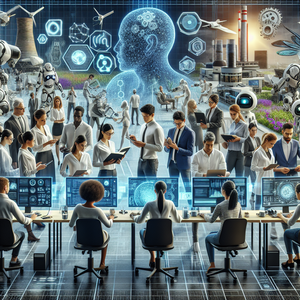From Blue-Collar to Digital Collar: The Workforce Transformation in the Age of Technology

The term "digital collar" describes jobs that integrate technological and digital competencies with the hands-on expertise traditionally associated with blue-collar roles. These positions involve tasks like operating advanced machinery, managing robotics, programming automated systems, and analyzing data to optimize processes. The driving force behind this transition is the rise of automation and digitization across industries. According to the McKinsey Global Institute, up to 25% of workers worldwide may need to shift to new occupational categories by 2030 due to the integration of technology into the workforce. For blue-collar workers, this could mean transitioning from manually operating assembly lines to programming robotic systems or from managing inventory manually to using AI-powered logistics platforms. However, this shift is not merely about replacing old roles with new ones. It is about creating opportunities for workers to thrive in a tech-driven economy. The rise of digital collar roles has the potential to enhance productivity, reduce operational inefficiencies, and foster economic resilience—provided that workers are equipped with the right skills.
Workforce Redeployment: The Role of Upskilling
The transition from declining blue-collar roles to growing digital collar opportunities hinges on one pivotal factor: upskilling. Upskilling refers to equipping workers with new, in-demand skills that align with evolving job requirements. It is the cornerstone of workforce redeployment, ensuring that workers are not displaced but repositioned for success. Manufacturing is a prime example of an industry where upskilling is critical. As factories become smarter and more automated, traditional assembly line jobs are being replaced by roles that require workers to program and maintain robotic equipment. Siemens, a leader in industrial automation, has embraced this transition through its Mechatronics Certification Program. By collaborating with academic institutions, Siemens provides factory workers with the training needed to operate and service advanced machinery. This not only empowers workers to take on higher-paying, technology-driven roles but also helps the company meet its need for skilled talent in an increasingly automated environment. Governments also play a crucial role in facilitating workforce redeployment. Singapore’s SkillsFuture initiative is a prime example of a national effort to prepare workers for the future of work. The program provides workers with financial grants to pursue certifications in high-demand digital fields, such as data analytics, cybersecurity, and AI. By focusing on lifelong learning and accessibility, SkillsFuture has become a model for how governments can proactively address the challenges of workforce transition.
Public-Private Partnerships: A Collaborative Approach
The success of workforce redeployment depends on collaboration between industries, governments, and educational institutions. Public-private partnerships (PPPs) are essential for developing scalable, sustainable solutions that address the needs of both workers and employers. The logistics industry is undergoing rapid transformation due to automation and AI. Companies like FedEx and DHL have introduced programs to train employees in using advanced technologies, such as automated sorting systems and AI-driven delivery tools. These initiatives are often developed in partnership with tech companies and local job training organizations. By pooling resources and expertise, PPPs ensure that workers gain practical skills while employers build a pipeline of qualified talent. Even the retail sector, traditionally a hub for blue-collar employment, is embracing the digital collar revolution. Walmart’s Live Better U initiative provides employees with affordable access to education in technology-related fields. Workers can pursue degrees in data analytics, systems management, and software development, preparing them for roles that extend far beyond the retail floor. Such programs demonstrate how companies can invest in their workforce to drive both employee growth and organizational innovation.
Overcoming Barriers to Workforce Transition
While the shift from blue-collar to digital collar roles presents immense opportunities, it also comes with challenges. Many workers face barriers such as limited access to education, financial constraints, and anxiety about adapting to new technologies. Addressing these obstacles is critical to ensuring an equitable transition. One solution is to make training programs more accessible. Online learning platforms like Coursera, Udemy, and LinkedIn Learning have partnered with governments and organizations to offer free or low-cost courses in high-demand skills. These platforms allow workers to learn at their own pace, making it easier for those with existing job or family responsibilities to participate. Financial support can also play a transformative role. Companies can offer paid training hours or cover tuition costs for employees pursuing certifications. Governments, in turn, can provide tax incentives to employers that invest in workforce development. For example, Amazon’s Career Choice Program funds up to 95% of tuition costs for its employees, enabling them to transition into tech-focused roles such as IT support and cloud computing. Perhaps most importantly, fostering a growth mindset is essential. Workers must view career transitions not as a loss of their identity but as an opportunity to grow and thrive. Employers can support this mindset by celebrating success stories, offering mentorship programs, and creating environments where continuous learning is valued.
The Future of Work: Thriving in the Digital Age
The transition from blue-collar to digital collar roles is more than a workforce trend—it is a critical societal shift. As industries continue to embrace automation and technology, workers must be empowered to adapt and succeed. This transformation offers a unique opportunity to redefine the nature of work, creating jobs that are not only more resilient but also more rewarding. The key to success lies in collaboration. Companies must invest in upskilling their employees. Governments must create policies that support lifelong learning and workforce innovation. Educational institutions must design programs that align with industry needs. Together, these stakeholders can ensure that the shift to digital collar roles is inclusive, equitable, and effective.
The move from blue-collar to digital collar jobs represents a profound opportunity to shape the future of work in the 21st century. By prioritizing workforce redeployment and upskilling, we can create a world where workers are not left behind in the face of technological disruption but are instead empowered to thrive. This transformation is not just about surviving the changes brought by automation—it’s about embracing them to build a more innovative, resilient, and inclusive workforce. The digital collar revolution is here, and with the right strategies in place, we can ensure that workers, businesses, and societies rise to meet its challenges and opportunities. Let us not only adapt to the future of work but actively shape it for the benefit of all.
Industrial Automation Technician
Siemens, ABB, General Electric (GE), and Honeywell
Core Responsibilities
Operate, maintain, and troubleshoot automated machinery and robotics used in manufacturing processes.
Program and configure PLCs (Programmable Logic Controllers) to optimize production efficiency.
Perform diagnostics and repairs on sensors, actuators, or robotic systems.
Required Skills
Proficiency in PLC programming languages (e.g., Ladder Logic, Structured Text).
Understanding of industrial systems such as SCADA and HMI software.
Experience with tools like Allen-Bradley or Siemens automation platforms.
Logistics Data Analyst
FedEx, UPS, Amazon, and DHL
Core Responsibilities
Analyze supply chain data to identify inefficiencies and recommend process improvements.
Use predictive analytics tools to forecast inventory needs and optimize delivery routes.
Develop and maintain dashboards to track KPIs such as delivery times and cost savings.
Required Skills
Expertise in tools like Tableau, Power BI, or Python for data visualization and analysis.
Strong knowledge of supply chain management software (e.g., SAP, Oracle NetSuite).
Familiarity with machine learning applications in logistics.
Smart Factory Systems Specialist
Bosch, Rockwell Automation, Intel, and Schneider Electric
Core Responsibilities
Design and implement IoT-enabled systems to monitor and control smart factory operations.
Integrate sensors and edge devices into production lines for real-time data collection.
Collaborate with IT teams to ensure cybersecurity of connected systems.
Required Skills
Familiarity with IoT platforms (e.g., AWS IoT, Azure IoT Hub) and protocols (e.g., MQTT, OPC-UA).
Experience with edge computing and data analytics in manufacturing contexts.
Knowledge of cybersecurity standards for industrial environments.
AI-Powered Retail Systems Specialist
Walmart, Target, Best Buy, and Kroger
Core Responsibilities
Implement and manage AI-driven inventory management and customer experience tools.
Analyze sales data and customer behavior using machine learning models to improve product recommendations.
Train retail staff to use AI-powered systems effectively.
Required Skills
Proficiency in AI/ML tools such as TensorFlow, PyTorch, or OpenAI APIs.
Experience with retail automation software like Blue Yonder or Oracle Retail.
Ability to bridge technical concepts and business goals for non-technical stakeholders.
Digital Health Equipment Specialist
Medtronic, Philips Healthcare, GE Healthcare, and Cerner Corporation
Core Responsibilities
Install, maintain, and train healthcare staff on the use of advanced digital medical equipment (e.g., AI diagnostic tools, telemedicine platforms).
Monitor and troubleshoot connected medical devices to ensure accuracy and compliance with healthcare regulations.
Collaborate with IT and clinical teams to integrate digital tools into patient care workflows.
Required Skills
Knowledge of healthcare technology standards like HL7, FHIR, and HIPAA compliance.
Expertise in connected medical devices, wearable tech, and remote monitoring systems.
Strong problem-solving skills in high-pressure healthcare environments.


